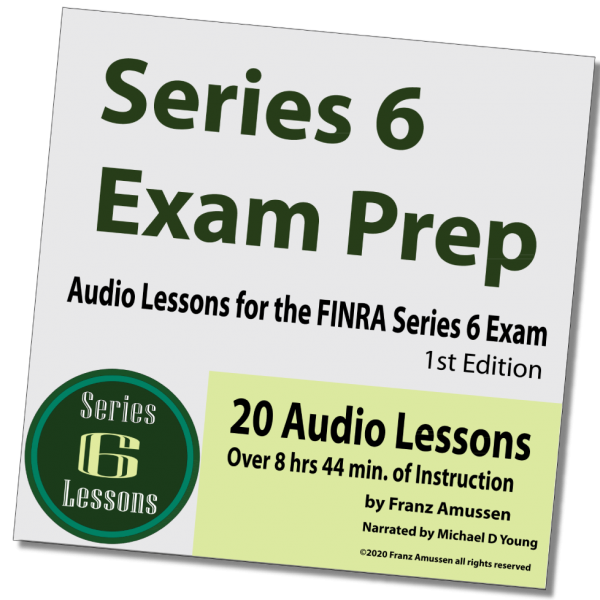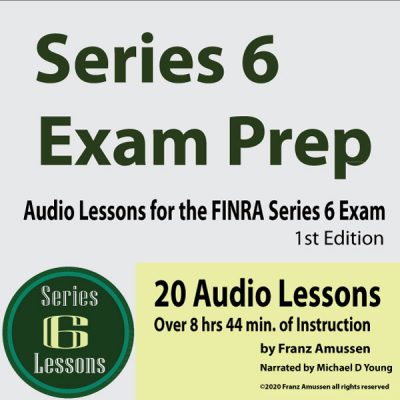Series 6 Lesson 10 Annuities
Series 6 Lesson 10 Annuities are covered in this lesson
This is an investment sold by an insurance company that promises a minimum rate of return or allows the investor to allocate payments to different mutual funds that invest in stock and bond markets. They pay out regular payments throughout the rest of the investor’s life, or they can take out money in lump sums as needed. They are often used as part of retirement plans.
Three kinds: fixed, indexed, and variable.
A fixed annuity promises a minimum rate of return in exchange for a large payment once, or a series of smaller payments over time. These are known as purchase payments. This is good for someone who needs safe money, but the rate of return is not good.
An indexed annuity gets a minimum rate of return, but can get a higher rate of return if a certain index, such as the S&P 500, has a good year. There is often a cap on how much more a person can get from this kind of annuity.
A variable annuity does not promise a particular rate of return. The rate can fluctuate The investor bears the risk rather than relying on the insurance company to guarantee a certain rate of return. People who own these can vote about decisions dealing with the annuity.
Annuities are pretty complex and so a person has a 10-day grace period in order to change their mind about purchasing annuities. (Free-look period) They provide a death benefit so that when the person dies, their beneficiary will receive a benefit paid out from the annuity.
For a deferred annuity, a person purchases the annuity and then waits for some time to receive payments. If the person wants to receive payments right away, they would buy an immediate annuity.
When payments are made out, several things are deducted, such as the sales charge, the administrative fee, and the state premium tax.
Life only annuities are only good for a person’s life and don’t pay out to another beneficiary upon their death. You usually get the largest monthly payout with these annuities.
A period certain annuity will be paid out no matter what for a certain time period. The person can name a beneficiary and the annuity will make regular payments until the term runs out. There is also an either/or option called life with period certain. If you have a 15 year period and then die after a year, the annuity will continue for the remaining 14 years.
The joint with last survivor gives the smallest monthly payment, because they have to pay out for the life of annuitant or his or her survivors.
Annuities have two phases: the accumulation period (pay-in) and the annuity period (pay-out). In the accumulation period, you either make one very large payment or you can make a series of smaller payments over time. Every time you make a payment, you get annuity units. The payment is created based on the annuitant’s age, the value of the account, the person’s gender, and the settlement option chosen. You will not have a health exam.
An insurance company separates its investments into two accounts: the general account and the separate account. Investments from the general account has a certain guaranteed rate of return. Investments from the separate account deal with the stock and bond markets, where there is a great degree of risk and fluctuation.
Life Insurance
Term life insurance is basically renting life insurance for a certain time period. You will pay a low monthly premium. If the insured person dies within the period, there is a death benefit for a beneficiary, such as a spouse or other family member. At the end of the term, the insured person can renew their coverage if they want. Because he is older, the premiums will likely go up. It does not build up any cash value over time.
Whole life insurance is like buying instead of renting. It builds up cash value over time and it does not an expiration date. The insurance company guarantees a minimum cash value that will be paid out when the person dies, but the monthly premiums is also much higher than buying term life insurance. The money in it grows tax deferred.
Universal life insurance provides a greater degree of flexibility. You can adjust how much you are paying in to increase the coverage or you can pull back on your premiums if you are short on cash. This is a type of whole life insurance, so you will still be gaining in value.
Variable policies, unlike whole life or term life policies, fluctuate. Their cash amount and the death benefit is variable, depending on the performance of the separate account on which it is based. (Stocks and bonds) It still grows tax deferred. When the person cashes in the policy, they get whatever the policy happens to be worth at the time. Usually, a minimum fixed death benefit is established, known as the floor. There are also Universal Variable Policies, which combine the aspects of both kinds of policies.
In kinds of policies that have cash value, you can take out a loan from the cash value of the policy, which will reduce the cash value and the eventual death benefit. You can only borrow a certain percentage of the cash value of the product.
There are different settlement options for these kinds of policies. These are ways for the beneficiary to be paid.
Lump sum = the beneficiary gets one big sum one time.
Fixed period = the beneficiary gets an equal fixed amount over a certain period of time. They include principal and interest.
Fixed amount = the beneficiary gets a fixed amount every month until the principal and interest runs out.
Life Income = means that the person will get a benefit for the rest of their natural life.
Interest Only = the insurance company invests the proceeds from the investments and they get a guaranteed rate of interest.
You have two years after getting a variable policy to switch back to a traditional one.
Series 6 Lesson 10
We also offer lessons for:
The Series 7 Exam
https://gumroad.com/l/ILYu
The Series 22 Exam
https://series6lessons.com/series-22-exam/
The Series 63 Exam
https://series6lessons.com/series-63-exam-lessons/
The Life Health Insurance Exam
https://series6lessons.com/insurance-lessons/
The SIE Exam (Securities Industries Essentials Exam)
https://series6lessons.com/finra-sie/
Click on any of them to find out more
Podcast: Play in new window | Download (Duration: 10:51 — 4.5MB)
Subscribe: Apple Podcasts | RSS | Subscribe to Podcast




